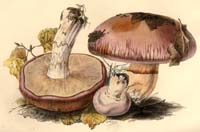 Key to Gilled Mushrooms Key
Key to Gilled Mushrooms KeyThis is a key to gilled mushrooms, that is, mushrooms having a definite cap with a fertile surface consisting of gills. The fruiting body usually also has a stem, although that may be lateral or absent (usually, then, the mushroom is growing from wood). You can use this key to identify mushrooms that you find.
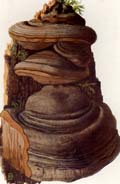 Polyporaceae Family
Polyporaceae FamilyFertile surface usually a layer of vertical tubes, of which the mouths are visible as pores on the underside of the cap or shelf.
Fruiting bodies usually tougher or harder than the "normal" gilled mushrooms, being leathery, corky, or woody. But they can be quite tender while actively growing
Once grown, they do not decay easily, remaining on the substrate for months or years
They often grow on wood, although a few are terrestrial (even those are usually growing on buried wood)
Fruiting body is usually a flat shelf, or hoof-shaped, protruding directly from the substrate, although sometimes it may have a short stalk.
Some forms never grow away from the substrate at all, so that all that is visible of the fruiting body are the pores.
Sometimes the pores are so minute that the fertile surface seems solid, until you look closely
 Lignicopolypore Subfamily
Lignicopolypore SubfamilyGrowing on wood
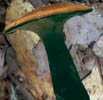 Stipitoporus Tribe
Stipitoporus TribeNot fitting the other choices, fruiting body with well-developed stem
Polyporus Genus Micheli: Fries
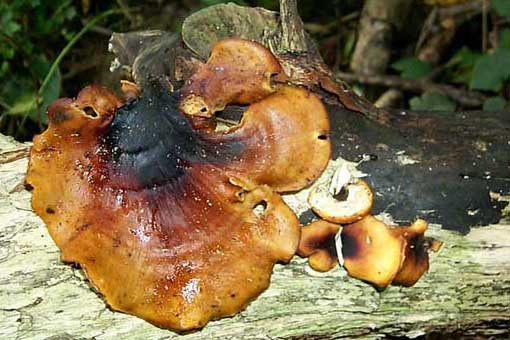
Diagnosis
- Cap lacking hard crusty upper surface or large, angular pores
-
Fruiting body flexible if it's not really thick
Narrow down your identification:
 Blackfoot Polypore Section
Blackfoot Polypore Section- Stem black, at least towards the base
Not Blackfoot Section
Polyporus variusCap pale tan to reddish tan, never shiny, soon weathering to a dull white; margin often wavy or lobed
Pores white at first, aging grey or brown
Up to 4" across; usually only about two
Often on dead twigs and small sticks

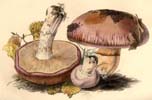


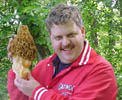

 Key to Gilled Mushrooms Key
Key to Gilled Mushrooms Key Polyporaceae Family
Polyporaceae Family Stipitoporus Tribe
Stipitoporus Tribe
 Blackfoot Polypore Section
Blackfoot Polypore Section




